With 1.5 million users and an expanding set of features, MailerLite has grown into an email marketing heavyweight since its 2010 launch. But with capable competitors like ConvertKit, Mailchimp, and ActiveCampaign, is MailerLite still worth it?
I've been a MailerLite user for nearly two years. Here's what initially sold me: unlike most email software, MailerLite's free plan gives you fully functional email automation features. (That's part of why it made Zapier's list of the best free email marketing software.) Like most users, I took advantage of MailerLite's free plan until I managed to build my list up to 1,000 subscribers. Over time, I've grown to appreciate more about this flexible email software—and I've also encountered a few of its shortcomings.
In this hands-on review, I'll explain what differentiates MailerLite, share the features that elevate it over competitors, and help you navigate whether it's the right email marketing software for you.
What is MailerLite?
MailerLite is a marketing automation platform focused on email marketing.
Like most email marketing providers, MailerLite started with email and has evolved into an all-in-one marketing platform. You can run an entire business from MailerLite if you take advantage of the platform's landing pages, websites, payment and eCommerce integrations, and marketing automation.
At its core though, MailerLite is still about email: collecting subscribers, sending newsletters, nurturing eCommerce customers, sending lead magnets, and tracking the effectiveness of your campaigns.
MailerLite vs. the competitors
Over the years, I've used Mailchimp, ConvertKit, and ActiveCampaign before ultimately switching to MailerLite. These are all good options, and you wouldn't be making a mistake by going with any one of them.
But in my experience, here's where MailerLite has the edge:
Ease of use: MailerLite has a shorter learning curve than any other email software I've tried. This is especially evident when it comes to automation workflows. I've found that competitors like ActiveCampaign, while more powerful, are less intuitive.
Design features: It's simple to design a beautiful email with MailerLite. The platform's templates are great, but where it stands out is its drag-and-drop design features. MailerLite's advanced widgets—like surveys, quizzes, and countdowns—can make your emails interactive and help you collect more robust data about your subscribers.
Generous features in the free plan: MailerLite's free version provides serious value. Some competitors design their free plans so you're forced to upgrade as quickly as possible: for example, Mailchimp has a monthly send limit of just 1,000 emails. Not so with MailerLite, which includes advanced features like automation workflows and A/B testing for free.
Here's how MailerLite's free plan stacks up to competitors on some key parameters:
Plan | # Subscribers | # Monthly sends | Automations | A/B Testing | |
|---|---|---|---|---|---|
MailerLite | Free | 1,000 | 12,000 | Yes | Yes |
Mailchimp | Free | 500 | 1,000 | No | No |
ConvertKit | Free | 1,000 | Unlimited | No | Yes |
Zoho Campaigns | Free | 2,000 | 6,000 | No | No |
AWeber | Free | 500 | 3,000 | Only 1 | No |
GetResponse | Free | 500 | 2,500 | No | No |
That doesn't mean MailerLite is perfect. If you need robust CRM features, ActiveCampaign is a better choice, and it's tough to beat ConvertKit's creator-oriented features if you're a solopreneur. And as much as MailerLite proudly touts its iOS integrations, I was disappointed to find there's no Android app—something that Mailchimp, ActiveCampaign, Zoho, and GetResponse all have.
MailerLite features
Email marketing
Here's how I use MailerLite's email automation features:
First, I incentivize visitors to subscribe with a "7-Day Challenge" and collect emails using MailerLite's forms and pop-ups.
Then, I use MailerLite to create a workflow that drips emails out over a series of days.
Finally, MailerLite delivers this content automatically to new subscribers.
Here's what the email workflow looks like on the back end.
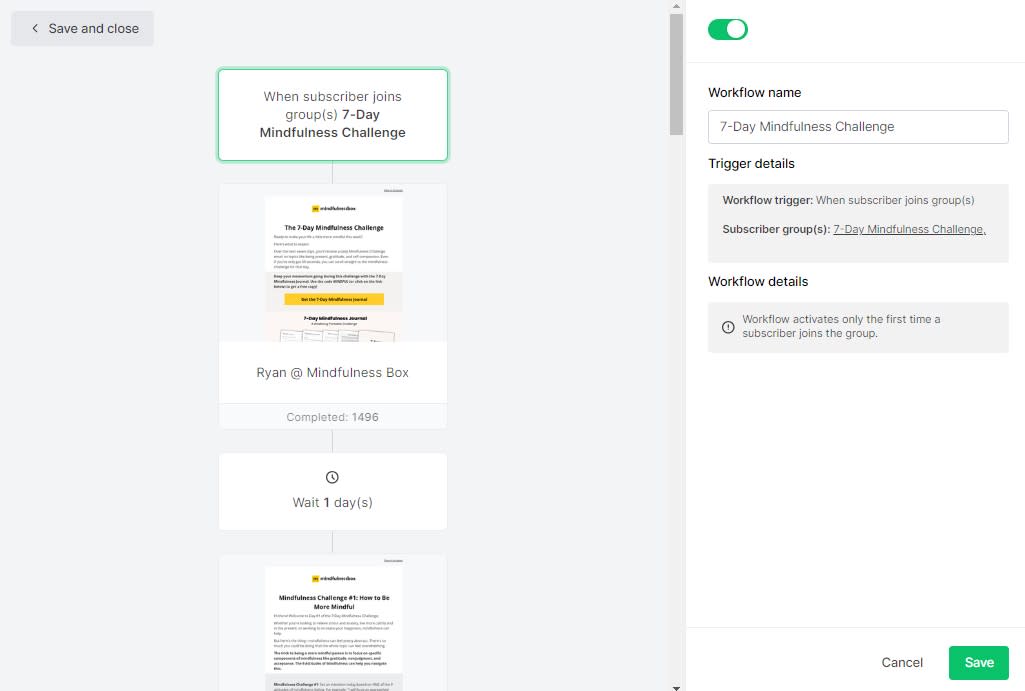
You can, of course, get much more complex than my "send email, wait one day" automation above. MailerLite lets you use multiple triggers to start your automations: you can fire off automations when an eCommerce sale happens, when a subscriber clicks a link, or when it's their birthday, for example.
Meanwhile, designing the emails is easy. MailerLite's drag-and-drop email builder strikes the right balance of intuitive versus powerful. It handles the essentials of email design well, providing a supremely clean user interface that makes it easy to do the heavy lifting of email design—dragging headings, paragraphs, and images onto the screen and juggling them into different layouts. MailerLite also formats emails neatly for both desktop and mobile devices and provides a built-in preview and testing tool.
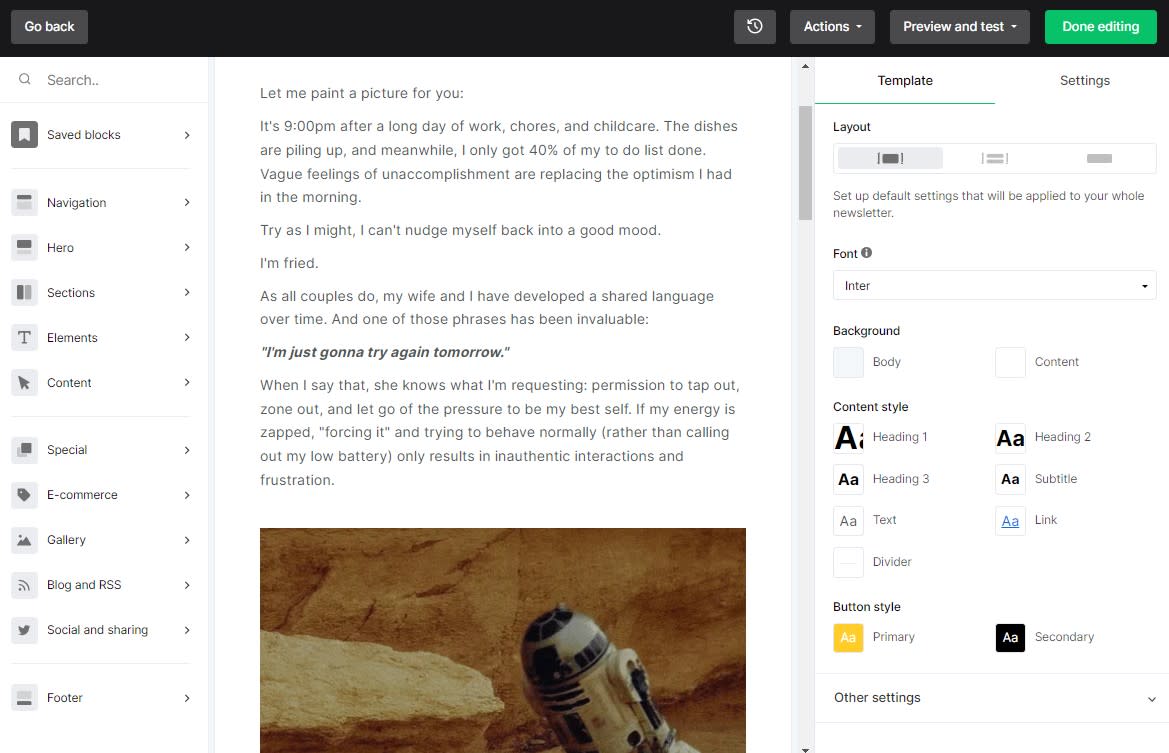
On paid plans, you get additional time-saving features like custom templates and the ability to make branding and footers consistent across your emails.
You can also embed surveys in emails, and MailerLite will recognize the answers, enriching your list by saving each user's response. Survey results appear right within your email campaign stats under a Survey report tab.
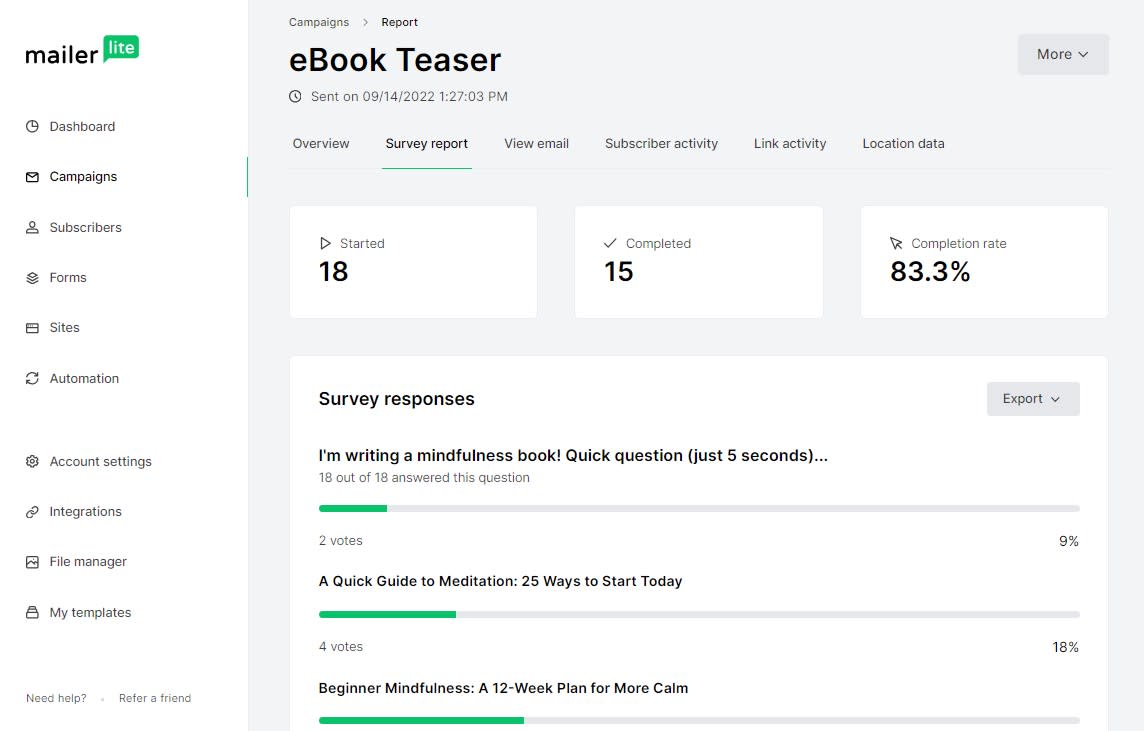
To make things easier, MailerLite connects to Zapier, which gives you the flexibility to add users from other sources into your MailerLite lists and email automations, so you can grow your list faster. Here are some examples of how it can work, but you can add users from thousands of different apps.
Add new Google Forms responses to MailerLite as subscribers.
Add subscribers to MailerLite from newly-updated rows on Google Sheets
Forms and pop-ups
Pop-ups get a bad rap, but it's hard to argue with their results. MailerLite has a number of cleverly-designed pop-ups that can increase sign-ups without driving your users crazy. I use two of the less intrusive pop-up options: exit intent, which displays when users are leaving the site, and slide up, which sticks to the bottom of the screen without disrupting the user experience.
MailerLite also offers embedded forms, so you can gather subscribers directly from your website. While these forms might not be as pretty as your website's native forms, I think it's a trade-off worth making because MailerLite's integrated form analytics let you see how each form is performing.
A/B testing is available on both pop-ups and embedded forms. I've made extensive use of A/B testing: the winning variant is often not what I expected, and it's helped me to nudge up my conversion rates over time.
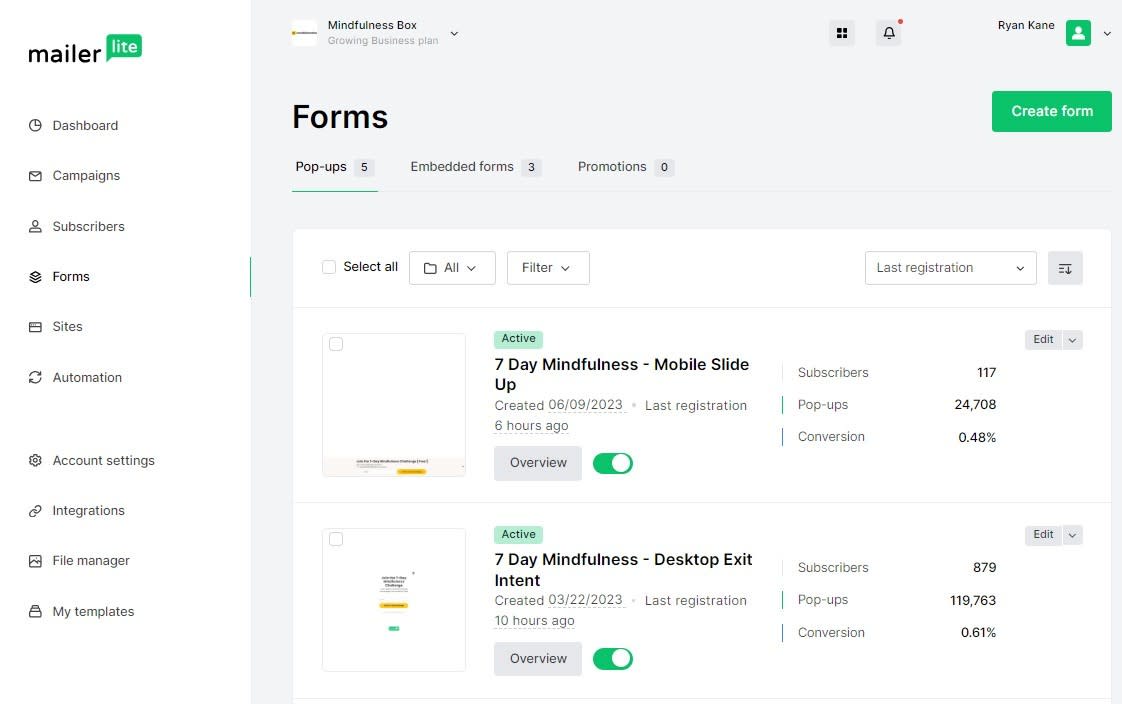
If you're using MailerLite's forms, you won't need integrations. But if you're collecting subscriber email addresses using the forms on website builders like Webflow or Squarespace, Zapier can bring everything together.
Create or update MailerLite subscribers from new Webflow form submissions
Create or update MailerLite subscribers from new Squarespace form submissions
Landing pages
MailerLite has two website builder options: landing pages, which are one-page websites for specific campaigns, and websites, which are full websites complete with navigation menus.
Of the two, landing pages have the clearest use case for MailerLite's audience of email marketers. Many types of emails—especially promotions—benefit from campaign-specific landing pages to increase conversion rates. MailerLite's templates make this easy.
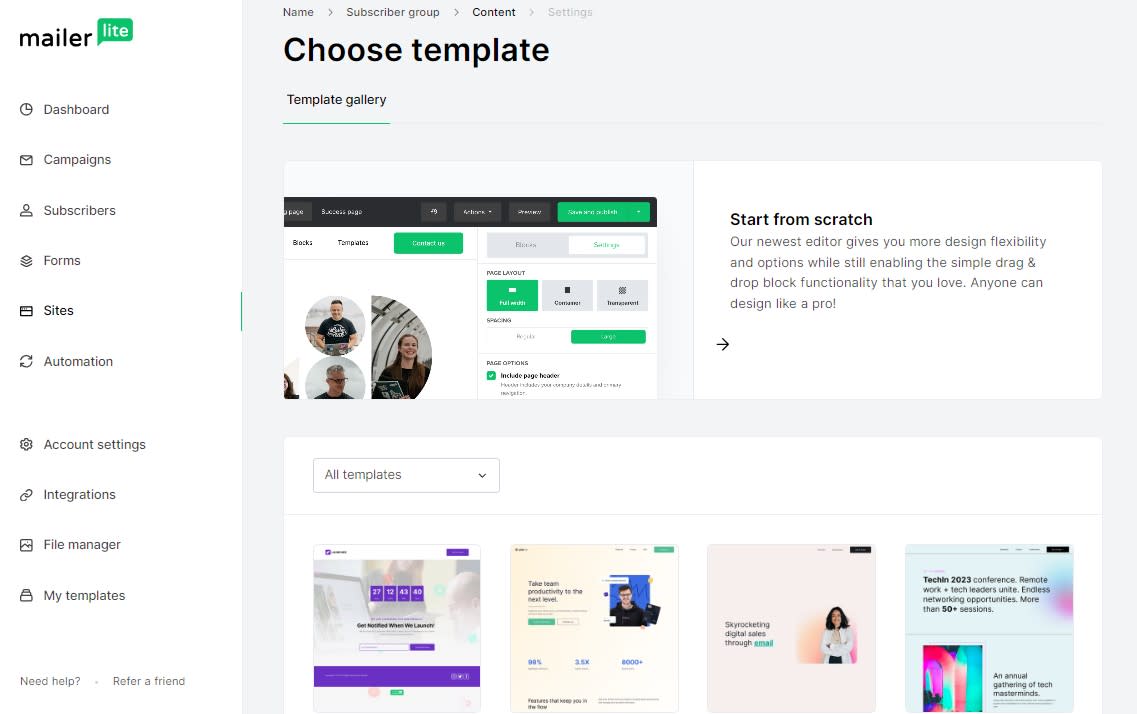
I have a harder time finding a use for the website builder. While it's nice to have the option, it's rather barebones and certainly can't compare to website-specific platforms like Squarespace.

MailerLite's landing pages and websites do have some built-in advantages.
Actions taken on your landing page—like surveys—enrich your list and are reflected in your MailerLite dashboard. Your dashboard also makes it easy to see the views, subscribers, and conversions attributed to each landing page.
And MailerLite integrates a few interactive features into its builders that you won't see on other website building platforms. For example, you can drop your newsletter archive directly into your website or run interactive quizzes from your website.
Analytics
MailerLite's in-dashboard analytics offer substantial data without becoming overwhelming.
The main analytics view—called Performance overview—shows the total number of active subscribers and lets you compare them against other periods to see trends. You can also see the number of campaigns and number of emails you've sent, the average conversion rate across all forms and pop-ups, and the number of people currently going through your automation workflows.
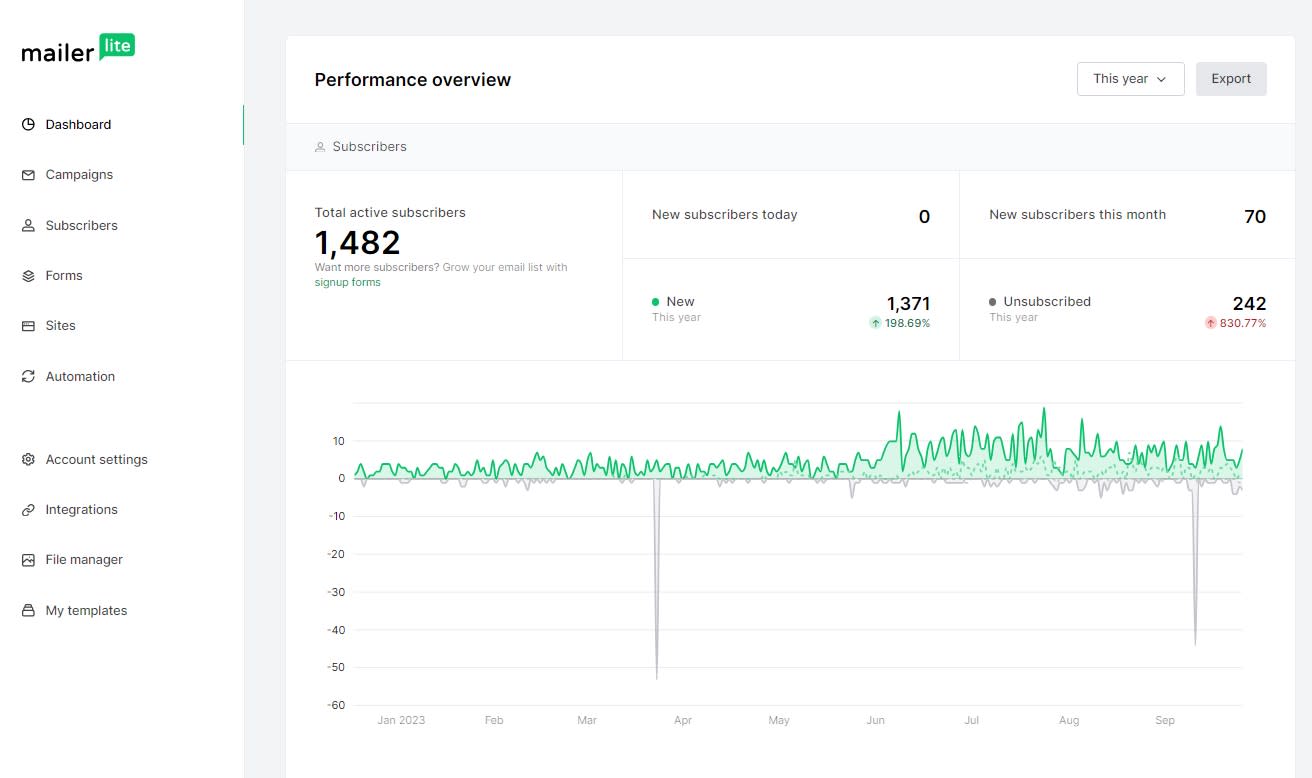
Each individual campaign has its own easy-to-understand analytics dashboard, too. You can see the standard email statistics—open rate, click rate, bounce rate—along with link activity, a desktop versus mobile comparison, and your click-to-open rate. My favorite features are the clean data visualizations: a chart that shows when subscribers open your emails and a map that displays where all your subscribers are located.
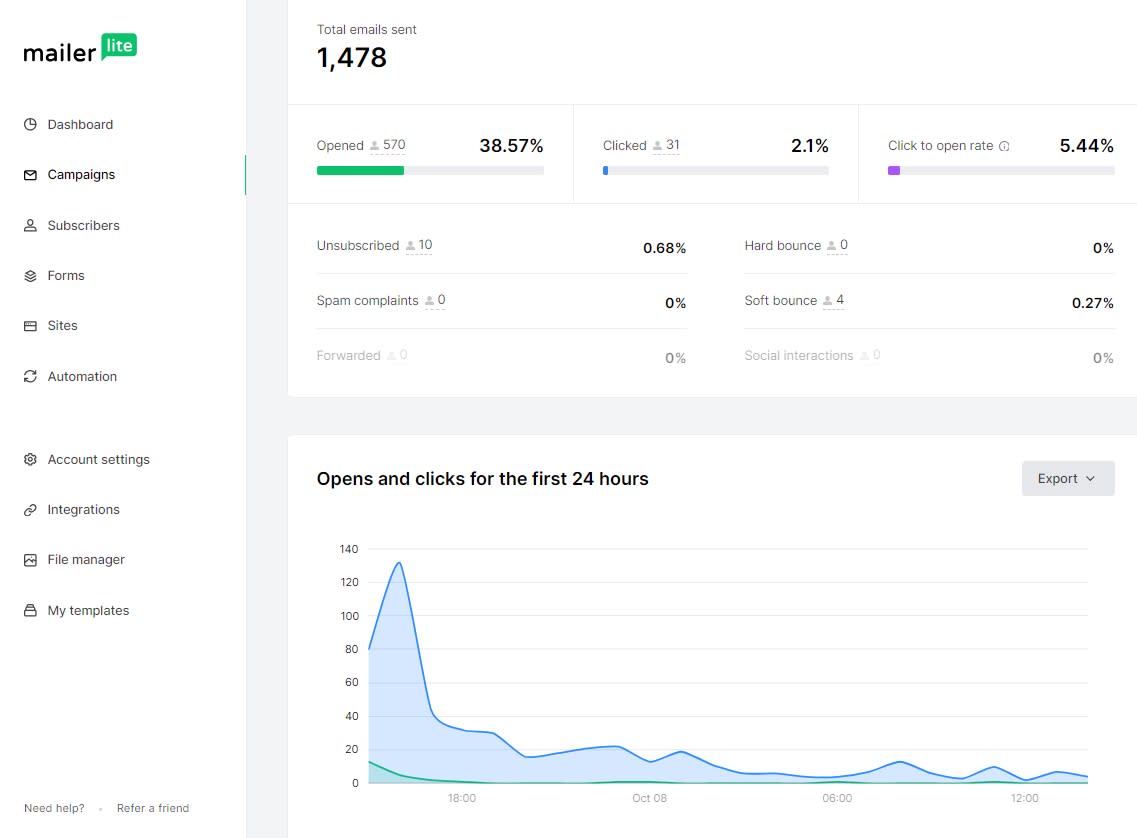
eCommerce and digital products
You can integrate MailerLite directly with eCommerce platforms like Shopify, WooCommerce, BigCommerce, and PrestaShop. This unlocks the ability to trigger email sequences when customers buy your products, suggest upsells and cross-sells based on recent purchases, and send abandoned cart emails to drive sales.
By importing your eCommerce products into MailerLite, you can display product images and descriptions dynamically in your emails. MailerLite makes this easy with plenty of eCommerce-oriented email templates, and it lets you track your sales performance to make sure your email campaigns are effective.
MailerLite also promotes its ability to sell digital products and paid newsletters through its Stripe integration. This isn't a particularly built-out feature, but it could be handy if you want to test the waters without jumping onto a different platform.
Using Zapier, you can integrate MailerLite with more eCommerce and digital products platforms, in a more customized way, to ensure you don't miss any chances to build your subscriber list.
Create MailerLite Subscribers from New Gumroad Sales
Getting the most from MailerLite
If you're building an email list from scratch, and you're looking for a robust set of free marketing automation features, MailerLite is probably the right solution for you. MailerLite gives you everything you need for free, and charges a reasonable rate (starting at $15/month for 1,000 subscribers) as your audience grows.
MailerLite can't do everything: its website, digital product, and paid newsletter features feel basic. And if you need sales CRM integration or advanced workflow triggers, you may want to look elsewhere.
But MailerLite's core email marketing features offer an intuitive user experience, slick design features, and unbeatable value.
Related reading:




